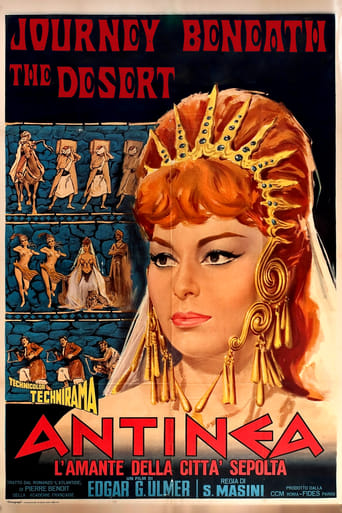Sexylocher
Masterful Movie
Protraph
Lack of good storyline.
TrueHello
Fun premise, good actors, bad writing. This film seemed to have potential at the beginning but it quickly devolves into a trite action film. Ultimately it's very boring.
FrogGlace
In other words,this film is a surreal ride.
MARIO GAUCI
This marks the fourth adaptation of Pierre Benoit's fantasy novel (but the sixth film since 3 contemporaneous versions were made in 1932 by G.W. Pabst in German, French and English!); it is only the second I have watched myself (after the 1932 English one) via a 93-minute print sporting French dialogue (though, according to the IMDb, the official language was either Italian or English and the running time 105)! For the record I also own the 1921 original, the 1932 French version and the maligned SIREN OF ATLANTIS from 1949; having said that, I have besides the unrelated George Pal spectacular ATLANTIS, THE LOST CONTINENT (1961; which I did catch years ago) and I would be interested in checking out 2 more adaptations: the 1972 made-for-TV one starring Ludmilla Tcherina and Bob Swaim's 1992 version featuring Fernando Rey and Jean Rochefort (an Italian TV screening of which I once had to abort because it was being shown way too late)! Anyway, I had long wished to see this French/Italian co-production (known in the U.S. as JOURNEY BENEATH THE DESERT), not only in view of the adventurous subject itself but also because two directors I greatly admire – Frank Borzage and Edgar. G. Ulmer – had been involved in the project (the former actually bowed out due to ill-health and was replaced by the latter). Besides, the cast was an interesting mix of old and new international talents like Israeli Haya Harareet (amusingly, her name does not appear on the copy I watched since the picture was blacked-out where it was supposed to be!), Frenchmen Jean-Louis Trintignant and Georges Riviere, and Italians Amedeo Nazzari, Gian Maria Volonte' (curiously enough, he would follow this immediately with Vittorio Cottafavi's popular and more traditional genre effort HERCULES AND THE CAPTIVE WOMEN aka HERCULES AND THE CONQUEST OF ATLANTIS!) and Gabriele Tinti. Since there were no major English-speaking stars featured, I opted to go with the French-language version from the two options available to me because, after all, two of its heroes emanated from that country! Besides, oddly enough for peripherally belonging to the peplum genre and being halfway a native production, it has never been shown on Italian TV! Interestingly, the plot has been updated here to coincide with the-then topical concern of nuclear testing; in fact, the film begins with a chopper bearing 3 geologists (Riviere, Trintignant and one Rad Fulton) flying over such a zone in the desert and, firstly, being ordered by radio to change routes and, then, trying to warn an apparently oblivious caravan passing beneath them of the danger they are running into. Forced down by a sand-storm and hilariously losing the chopper when it is blown off the edge of a cliff (while they are not!), the trio take shelter in some nearby caves. Later, they contrive to save the life of the nomadic leader (Nazzari) they had earlier come across – unaware of his murderous intentions, having had his men wipe out a number of escaping slaves via machine-gun fire! However, the group falls out with him soon after when they discover he is harboring precious minerals and has no intention of sharing; eventually, he takes them prisoners and they are made to witness a ceremony involving a snake dance in which the human participant is strangled by the reptile...but only so as to be reborn in the image of Antinea, ancient and legendary Queen of the equally mythical Atlantis (which Nazzari explains was not swallowed by the seas as the history-books have it but rather the sands of time)! So far so good: the film looks mighty fine (the production was designed by Ulmer himself, and he even co-wrote the script!) and features a wonderfully lush score courtesy of Carlo Rustichelli. However, it falters through Harareet's essential inexpressiveness and her unconvincing obsession – to Nazzari's outspoken chagrin – over the bland Fulton (Riviere is unceremoniously disposed of early on by being covered, inexplicably naked and with his head clean shaven, in gold!). Trintignant's own romance with Giulia Rubini (who, like them, had been one of several to be 'shanghaied' over the centuries and who has actually been promised by Nazzari to his lieutenant Volonte') is equally unbelievable: why Harareet does not take up with Trintignant herself (though she does induce him to carry out an attempt on Fulton's life!) who, being the scholarly type is clearly the most partial to Antinea's cause, makes for another baffling mystery! Besides, the sheer fact that we are never told just what goes on in Atlantis: they constantly work an underground mine but to what end…unless they are engaged in trading diamonds with the outside world which, however, would make their self-imposed 'exile' pointless? While rebellious slaves are confined inside a cage at the mercy of the currents, Fulton and Tinti manage to escape and subsequently battle it out with Nazzari and Volonte', with the former forced to shoot the latter when going against Harareet's wishes not to harm her lover!Typically, too, the over-confidence displayed by the people of Atlantis equates narrow-mindedness as they believe it can withstand anything, even The Bomb…but, of course, are proved wrong when the continent is summarily destroyed in the ensuing detonation; unsurprisingly, Trintignant and Rubini contrive to emerge from the rubble unscathed – having reached the safety zone in time – ready to start a new life together in the world above (and beyond) the desert. In the end, while the film does not to live up to expectations by honorably failing to deliver on its initial promise, the result proves nonetheless a stylish piece of hokum that is perhaps best enjoyed without thinking too much about it...
melvelvit-1
L'ATLANTIDE (aka JOURNEY BENEATH THE DESERT, 1961) certainly held promise -Hollywood director Frank Borzage may have started it but European émigré Edgar G. Ulmer finished up and it's his influence that's most apparent. Green, yellow, and blue lighting gave Atlantis an eerie look despite obvious budget restraints and the movie as a whole was well done of its kind but, unfortunately, it bore very little relation to Pierre Benoit's SHE-like source novel, "Queen Of Atlantis". The adult subject matter (filmed at least three times before) became kiddie matinée fodder with an extremely simplistic storyline: a couple of mining engineers get lost in a Saharan sandstorm and discover the lost city of Atlantis where they have to convince its queen that an A-bomb testing site is directly above and her underground empire will be vaporized in 24 hours. The queen falls in love with one of them and that's all she cares about. That's it.Even though she isn't especially attractive, there's something about Israeli beauty queen Haya Harareet but I can't say the same for her Antinea who's neither immortal nor evil in this re-telling. Her only crime was falling in love in a NY minute and as if that wasn't silly enough, the yards and yards of chiffon she had on made her look like a burlesque queen. Jean-Louis Trintignant and Gian-Maria Volonte didn't have much to do in this Saturday morning time-waster.
dbdumonteil
This is eminently debatable! Pabst 's version was perhaps not his best or among his best but it retained a certain pristine charm,some magic,even an unexpected twist.Brigitte Helm, Fritz Lang's Maria in "Metropolis" only appeared about fifteen minutes but she had mystery and hieratic qualities going for her.Haya Harareet -who was a good Esther in "Ben Hur "- portrays a two-bit queen ,who seems to be in one of these cheap Peplums with muscle men whereas the Legionnaires from Pierre Benoit's novel have become civilians ,scientists to be precise .And -the writer would turn in his grave for when he wrote his book,this dreadful weapon (happy times ) did not exist -these men know that Atlantis is part of a no-go area cause an atomic bomb is going to explode any day now.It was a good idea to "update" a rather old-fashioned book -few people still read Benoit now in France whereas he was a best seller half a century ago and before -Doing so by mixing Peplum with sci-fi does not do the writer any justice.The screenplay is silly,as an user wrote ,and Jean -Louis Trintignant looks stupefied ,as if the story did not concern him.Gian Maria Volonte has a small supporting part of a villain.There are so many plot holes the story is sometimes difficult to catch up with:for instance ,John (Georges Rivière) disappears very early ,probably because he was looking forward to collecting his fee and leaving this incredibly stupid tale .
junkySTL
I love old adventure/fantasy movies like this, where the acting is over-done, the Technicolor is glowing, the art direction flawless, and the costumes so over-decorated you'd think it was Shakespeare In the Park. This one is no exception! It concerns a group of explorers who become stranded in the desert when trying to help a lost countryman. They save his life and are `welcomed' into the city of Atlantis, which, prior to common belief, actually sank into the sand. Once inside, however, they have to fight for their lives against a malicious queen, her servants, and the threat of an atomic bomb testing site near by. Elegant to the last frame, this is a movie to savor! Leave it up to Something Weird Video to preserve weird gems like this for people who love classic cheese ball movies that are made with passion and style.

